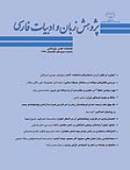ظرفيت طنز و نقد اجتماعی- اخلاقی در آثار فارسی شيخ بهايي
محورهای موضوعی : پژوهشهای ادبیات کلاسیک ایران
1 -
کلید واژه: شيخ بهايي كشكول گربه و موش طنز انتقاد ريا,
چکیده مقاله :
شيخ بهايي دانشمند بزرگ قرن ده و يازده هجري از هنرها و دانشهاي بسياري چون معماري، شعر، رياضي، نجوم، حكمت، فقه و حديث بهرهمند بود. اما، بيگمان، وجود طنز درآثار و افكارش و توجه او به نقد طنزآميز،ْ لطيفهاي غريب مينمايد و مقام شيخ الاسلامي و پايگاه و منصب فقهي و ديني او در دربار صفوي و در ميان مردم نيز وجود اين امكان را در انديشه و سلوك و آثار شيخ بسي دور نشان ميدهد؛ با اين همه واقعيت آن است كه طنز به عنوان ابزاري تأثيرگذار در كار انتقاد اجتماعي اخلاقي و آگاهي بخشي اجتماعي مورد توجه شخصيت ذوفنوني چون شيخ بهايي بوده است و علاوه بر وجود چند شعر و نوشتة طنزآميز در ميان آثار او، گرد آوردن و تدوين كشكول و قصة رمزي گربه و موش نيز به تنهايي از توجه شيخ بهايي به ابزار طنز و استفاده از آن در نقد رفتار و گفتار برخي مردمان حكايت دارد. در اين مقاله به ظرفيت طنز و نقد اجتماعي و اخلاقي در آثار فارسي بهايي پرداختهايم.
Sheikh Bahaee, the great religious scholar of the 10th and 11th centuries (A.H.), was also an architect, poet, mathematician, and astronaut. His high religious status as Sheikh- ul- Islam in the Safavid court and among the people makes it hard to think of the presence of satire in his works. Nevertheless, the fact is that Sheikh Bahaee has strategically employed satire as an effective means of criticism of society and morality of his time, as well as promotion of social awareness. In addition to some satiric poems and writings found in his works, he has also two completely satiric works named Kashkool (collection of writings), and Moush- o- Gorbe (Mouse and Cat), a symbolic story. Existence of hese works alone shows how Sheikh Bahaee concerned with satire in criticizing deeds and sayings of particular groups of people. This study then is an attempt to show the potential of satire, as well as social and moral criticism in Sheikh's Bahaee's Persian works.


